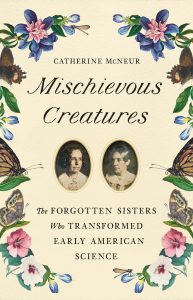Talking About Women’s History: Three Questions and an Answer with Catherine McNeur
Catherine McNeur is an associate professor of history at Portland State University where she teaches courses on environmental history, the history of science, food history, and public history. Her first book, Taming Manhattan: Environmental Battles in the Antebellum City, won the American Society for Environmental History’s George Perkins Marsh Prize, the New York Society Hornblower Award, the Society for Historians of the Early American Republic’s James H. Broussard Best First Book Prize, and the Victorian Society of America Metropolitan Book Prize, as well as dissertation prizes from Yale University, the American Society for Environmental History, and the Urban History Association. Taming Manhattan looks at how loose hogs running through the streets, urban sanitation debates, and the location of green spaces were integral parts of the social unrest facing New York City at a moment of dramatic urbanization.
In her second book, Mischievous Creatures: The Forgotten Sisters Who Transformed Early American Science, she uncovers the lives of the entomologist Margaretta Hare Morris and botanist Elizabeth Carrington Morris. Though both sisters were at the center of scientific conversations and debates in the middle of the nineteenth century, they’ve long been written out of histories of science. Mischievous Creatures recovers their lives and work, while also investigating how these erasures occur.
Take it away, Catherine!
What path led you to the Morris sisters? And why do you think it is important to tell their story today?
I never set out to write a book about the nineteenth-century scientists Margaretta Hare Morris and Elizabeth Carrington Morris. My plan had been to investigate the history of the much-hated (but sometimes loved) Tree of Heaven in American cities. However, while searching through the papers of a botanist who had written about that tree, I stumbled upon 250 letters written by someone named Elizabeth Morris. Googling her turned up very little at the time, not even a Wikipedia page, but I eventually learned that she was a botanist and her sister Margaretta was a renowned entomologist. Coincidentally, a month later I was doing some research in one of Harvard’s collections and fell across letters from Margaretta Morris. After reading through those letters, it was clear that Margaretta was struggling to be seen as a peer by other entomologists. “I have panted for the sympathy of someone who could appreciate my love of the science, and overlook my want of that learned love derived from books that are, generally speaking, out of woman’s reach,” she wrote. “The book of nature, however, has been widely spread before me, and countless hours of inexpressible happiness I have had in the study, there.”
I was captivated by Margaretta’s words and at the same time confused by the fact that no one had written about these women. Margaretta, after all, was one of the first women elected to the American Association for the Advancement of Science and the Academy of Natural Sciences. I wanted to know more about both sisters lives and also why we keep finding all these “hidden figures.” The fact that I stumbled across them was no mistake—many of their peers are similarly forgotten or erased and therefore hard to find in the archives. Recovering these stories, though, makes it possible to see that our current push to diversify the STEM fields has a long and complicated history where women were actually present at the very start of these professions.
Writing about historical figures like the Morris sisters requires living with them over a period of years. What was it like to have them as constant companions?
Writing biography really does require that you live with your subjects, doesn’t it? Delving into their scientific passions and discoveries, figuring out the romantic dramas affecting their lives, parsing the messages they sent to friends, even reading a neighbor’s gossipy diary that tracked their comings and goings—it all made nineteenth-century Philadelphia really come to life for me. These women, in many ways, feel very much like old friends now. This is perhaps especially true as they were my company (and my family’s company) during the COVID-19 lockdown.
I found, too, that they affected the way I experienced my daily life. Margaretta, for instance, adored what she called her “little friends the Insects” and never passed a spider web or a cluster of flies without stopping to see what she might find. On a neighborhood walk when I found myself engulfed in a cloud of tiny flies and began swatting them away from my face, I stopped to think that Margaretta might not have swatted them. Or as I was editing a chapter in a park and found a tiny beetle making its way across my page, I didn’t hurry to knock it away but instead spent some time closely observing it. In order to be conversant in Elizabeth research, I also ended up learning quite a lot about ferns and now I spend a lot of time reveling in all the maidenhair ferns, sword ferns, and licorice ferns I find on my neighborhood walks. By writing so passionately about entomology and botany, the Morris sisters transformed the way I, too, saw the world around me.
What unsung woman scientist from the past would you most like to read a biography of, and why?
One thing I learned quickly while doing research for this project is that there are so many little-known nineteenth-century women who were scientists and were as well-trained as many of the men who we know to be the “founding fathers” of various scientific fields. There are several women who should have biographies written about them, including Isabella Batchelder James, a botanist who studied the origin of plant scents among other subjects, and Sarah Coates Harris, another botanist who also lectured on women’s health and hygiene and fought for women’s rights in the mid-nineteenth century. One person who is really overdue for a new biography, though, is Dorothea Dix. She’s best known for her reform work with mental health asylums and her work managing nurses during the Civil War. However, she was also a scientist. She published articles in leading scientific journals about insects she had discovered and on all of her travels for work, she collected plant specimens and seeds and sent them to other botanists around the country. She was very much a scientist as well as a reformer, but that part of her life is little known. The biographies that do exist on her woefully underestimate both her and her work. She was a close friend of Elizabeth and Margaretta Morris and from what I’ve been able to find, she was likely in a romantic relationship with Margaretta. How I would love to read a book that truly takes her life and work seriously and sees her for who she was.
[Pamela butting in here: I spent a lot of time reading about Dorothea Dix when I was working on Heroines of Mercy Street and I didn’t read anything about Dix the scientist! Even the women whose stories are told are often reduced in the telling.]
A question from Catherine: Thank you so much for reading Mischievous Creatures and inviting me to participate in this wonderful exchange, Pamela! When I speak with readers at book events, I’m always delighted to hear what stood out to them or what they found relatable in the book. Was there any part that particularly captured your attention?
I am eternally fascinated by the ways in which women are erased from history, in this case by the process of creating scientific professions. Beyond that, I was intrigued by the fact that they were sisters, and the ways in which they worked together despite the differences in their fields of study and personalities. (Or perhaps because of those differences.) The comparison with the Blackwell sisters was unavoidable.
***
Want to know more about Catherine’s archival finds and writing?
Visit her website: https://www.catherinemcneur.com/
Follow her on Instagram: @catherine_mcneur_writer.
***
Come back tomorrow for three questions and an answer with historian and archaeologist Jane Draycott, author of Cleopatra’s Daughter






